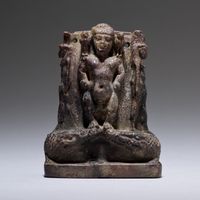
Kushite Pharaoh
An item at Metropolitan Museum of Art
Kushite kings wore distinctive regalia, including a cap crown, double uraei, and ram's-head amulets. On this kneeling king, the double uraei have been "corrected" to one, while the ram's-head amulets on the necklace and the king's name on his belt have been hammered out by a later Saite king. The cap crown with a falcon engraved in the back, the bandeau with streamers, and the diadem with many tiny uraei were left untouched. The small bronze kneeling figure represents two aspects of Kushite Period art that are intensifications of tendencies already extant in the Third Intermediate Period. Provision of small bronze royal attendant statuary demonstrated an specially pious regard for the gods and their temples. And, stylistically, there was an inclination toward models from the past, particularly the Old Kingdom, a taste clearly visible in the broad shoulders and narrow waist of the small bronze. The large gold ram's-head amulet 1989.281.98 is an actual example of the type that was worn on this king's neck cord.
Egyptian Art
An exhibit at Metropolitan Museum of Art
The Met collection of ancient Egyptian art consists of approximately 30,000 objects of artistic, historical, and cultural importance, dating from about 300,000 BCE to the 4th century CE. A signifcant percentage of the collection is derived from the Museum's three decades of archaeological work in Egypt, initiated in 1906 in response to increasing interest in the culture of ancient Egypt.




